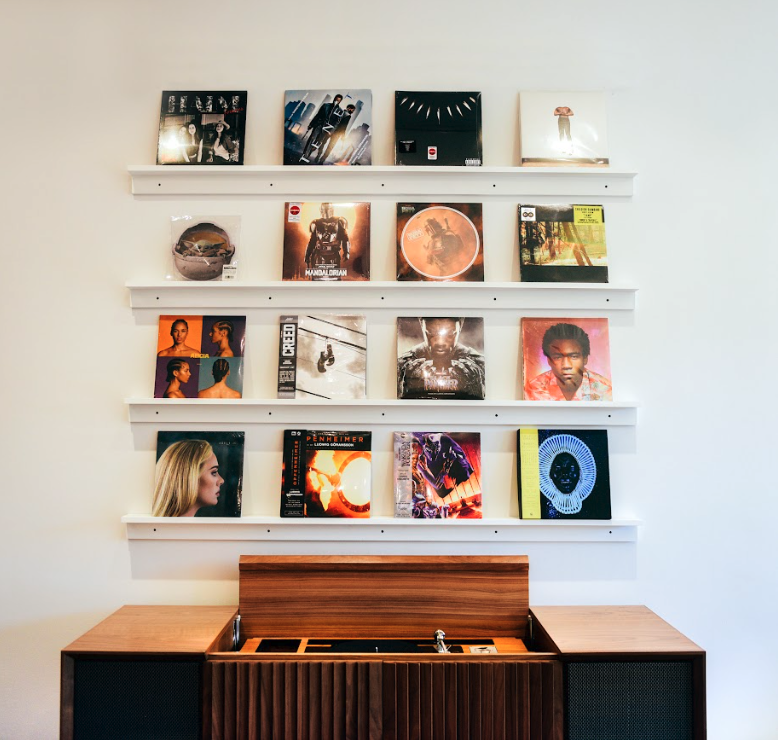 Ludwig Göransson drops the needle on the motion picture soundtrack for Oppenheimer, which received a Golden Globe this year for Best Original Score for a Motion Picture.
Ludwig Göransson drops the needle on the motion picture soundtrack for Oppenheimer, which received a Golden Globe this year for Best Original Score for a Motion Picture.
When Oscar-winning composer Ludwig Göransson was nine-years old, he heard a loud, unfamiliar noise coming from his father’s guitar studio. Lo and behold, when he opened the door, he discovered his father wildly headbanging to a confounding new sound: “Enter Sandman” by Metallica. “I had never heard that kind of music before,” Göransson remembers. With three years of guitar study with the tutelage of his father already under his belt, the newly discovered exotic guitar solos of heavy metal made the young boy wonder, “How do I play this music?”
 Ludwig Göransson’s discography of work on display.
Ludwig Göransson’s discography of work on display.
Göransson is the esteemed guest for Wrensilva’s The Records That Made Me listening event this month, fresh off another Academy Award nomination that same morning for his work on Christopher Nolan’s blockbuster Oppenheimer. His parents chuckle from the audience as Göransson reminisces on Metallica and files through his record collection in Wrensilva’s West Hollywood studio. He lays down a surprising influence to his composition work – a wax copy of Joe Satriani’s 1987 record ‘Surfing With The Alien.’ The record console erupts with a whoosh; Göransson smiles and points a finger at the turntable as Satriani’s brute electric guitar ignites. In a flash, the solo shifts from a high, glittery squeal down to a deep, grisly snarl, like the beam of a UFO drawing. Göransson shares, “The tone of the guitar . . . sounded like an alien to me, or the future, or [like] you’re on a different planet.”
Hearing beyond its feral surface, Göransson translates many of heavy metal’s complex features into his work across genres. Use of jerky, emphatic rhythms, muscular tempo changes, and dissonant harmonic structures often disguise his music’s intricacy with ferocity. Reaching new professional heights with recent Grammy nominations for the Oppenheimer score, Göransson utilized those mathematical qualities of music composition to capture the inner machinations of the film’s titular scientist. Working in a hexatonic scale, he wrote a didactic, arpeggiated motif that slows in tempo on the way up, and quickens in tempo on the way down. With each repetition, the scale gradually increases in speed. The resulting theme, “Can You Hear The Music,” features a prolific 21 tempo changes. Though it complicated the live recording process, Göransson welcomed the challenge. “When I make music . . . I always try to make something so it feels like I’m doing [it] for the first time,” he explained. “I think with rhythm changes and tempo changes, you can challenge yourself musically—at least I do that.” As the song spins out of the M1’s bass-reflex speakers, a crisp cascade of strings accelerate into a 3D soundstage, as if the listener is in the same room as the orchestra. The effect is at once dizzying and breathtaking.
The search for new challenges has propelled Göransson into a wide variety of projects throughout both scoring and music production. Whether it’s traversing funk and hip hop terrains with Childish Gambino, or traveling Africa with Baaba Maal to conduct research for the Black Panther score, Göransson resources inspiration not only by manipulating rhythm, tempo, and pitch, but also by expanding his arsenal of physical instruments. Colossally tasked with composing a brand new theme for the Star Wars franchise show The Mandalorian, he purchased six different recorders with which to experiment after watching a Keith Jarrett documentary. In the showroom, Göransson jumps the needle on a vinyl copy of Jarrett’s 1986 spiritual jazz album ‘Spirits’, landing on the second track. A wash of flutes and a piano pensively resonate throughout the space, lulling the audience into a brief meditation.
 Ludwig Göransson and Jason Bentley share a laugh as they prepare themselves for a captivating conversation on his music making process and his inspirations behind his scores.
Ludwig Göransson and Jason Bentley share a laugh as they prepare themselves for a captivating conversation on his music making process and his inspirations behind his scores.
It seems that peering through doors feeds the intrigue that originally led Göransson to witness his father headbanging down in the basement studio. Asked by moderator Jason Bentley about the common threads between his diverse collaborations, Göransson traces his chameleonic musicianship back to an innate sense of curiosity to engage with the sounds and people around him. “When you’re in school . . . everyone’s talking about [how] ‘you need to find your own voice,’” he reflects. “To me, any time I heard that sentiment it just made me very stressed . . . because [my] first thought was that you have to close yourself in and be by yourself.” While surrounded by students studying jazz, classical, and folk at the Royal College of Music in Stockholm, Göransson would pop into neighboring practice rooms. “You could just open the door and talk to people and say, ‘Hey what are you doing?’” he continues. “‘Do you like this music? Do you like that music? . . . Can you teach me something? Can we have some kind of exchange?’ So, I think there’s always been kind of a curiosity from my side to learn more about people.” Behind the first door, he found a vinyl Metallica record; behind another, the avant jazz of Keith Jarrett. What will Göransson find behind the next?
